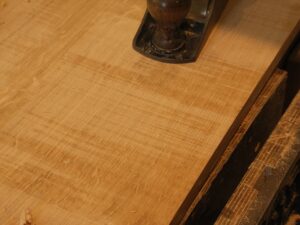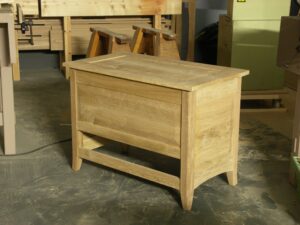Hope Chest and plane talking
I see woodworkers muscling their heavier-than-ever-before plane to the wood and I wonder how got here. Somehow a plane has become something rigidly forced not loosely presented, new not worn, dead flat not nicely rounded, tight-threaded not spinable. Fact is, they all work regardless and some of the older planes with that well-worn, old slipper look and feel somehow launch into action with the readiness of a well-trained English Springer spaniel.


Today I focussed on the Hope Chest and made the mortise and tenoned frame for the lid using only hand tools. A couple of things spring to mind that I would like to share. The first is that the #4 and #5 Stanley lightweights I used from the 50’s will flatten a 15″ by 36″ long panel in quartersawn oak in minutes dead flat. The second is that my wooden plough plane bit through knots and reverse grain with the rapidity of an Exocet missile.

So here is my lid replete with fully hand cut mortise and tenon and its raised panel that came from my two planes above with such perfection and ease.

Well worn planes are wonderful to use and if you can find one that’s been well used by a working craftsman for 30 years and worn some you will enjoy it as much or more than any other. The lighter weight is most useful and gets the job done very nicely. Before they told me that a sole of a plane must be dead flat to get good flat results I was doing fine getting good flat results.
You really don’t need to bulldog planes down onto the wood if your plane is sharp and set to task, wood and purpose. Relax just a little, feel for the wood at the cutting edge of the iron. Let this tell you about the wood, the grain type, direction. ‘Feel’ for the information you need and let your arms transmit the result as you shift in response. At times consider whether to reduce pressure when stubborn grain resists you; consider a change in direction.


Please send information on past and current efforts. I very much appreciate your blog and videos. I am setting up a small basement shop and appreciate your approach to working with wood.